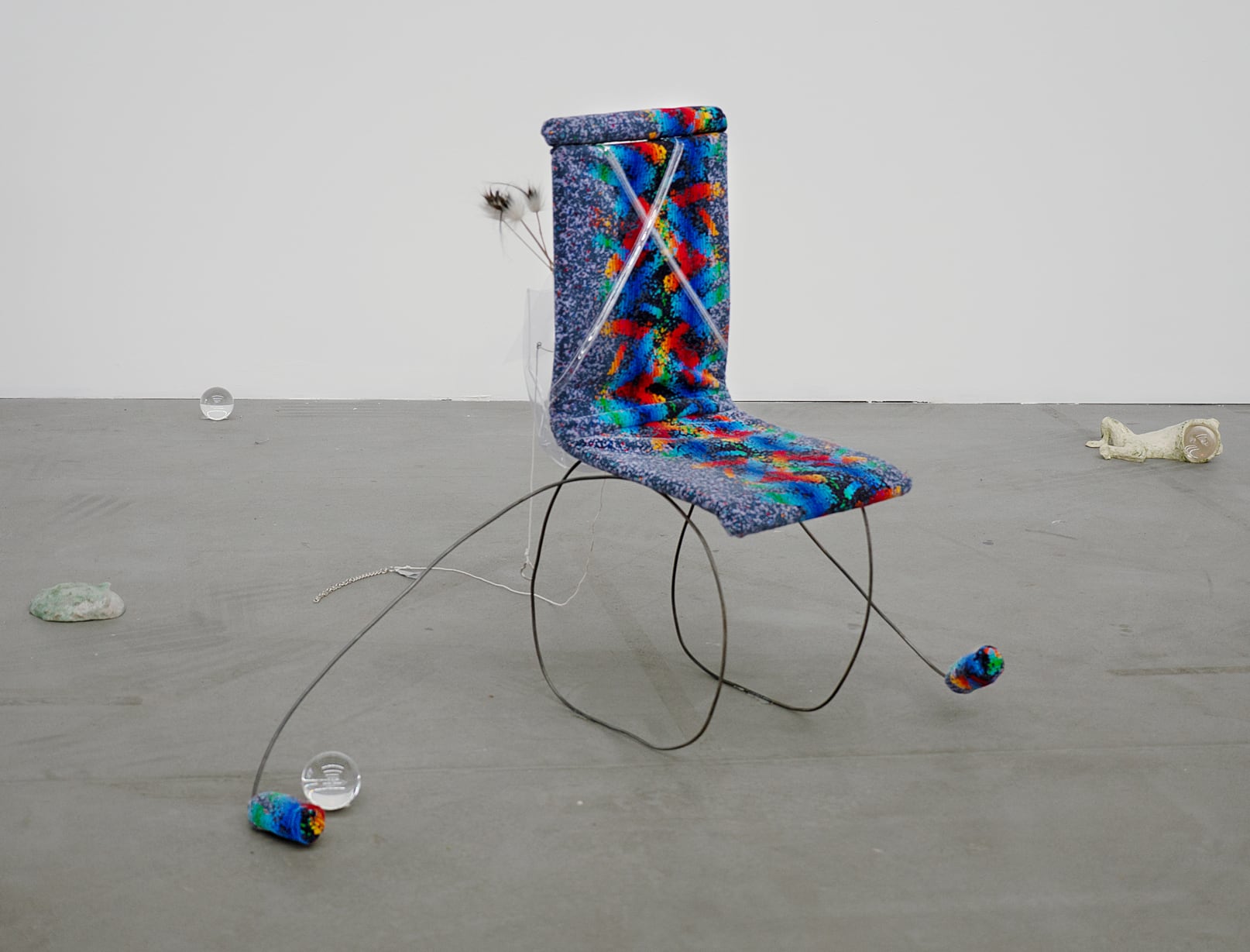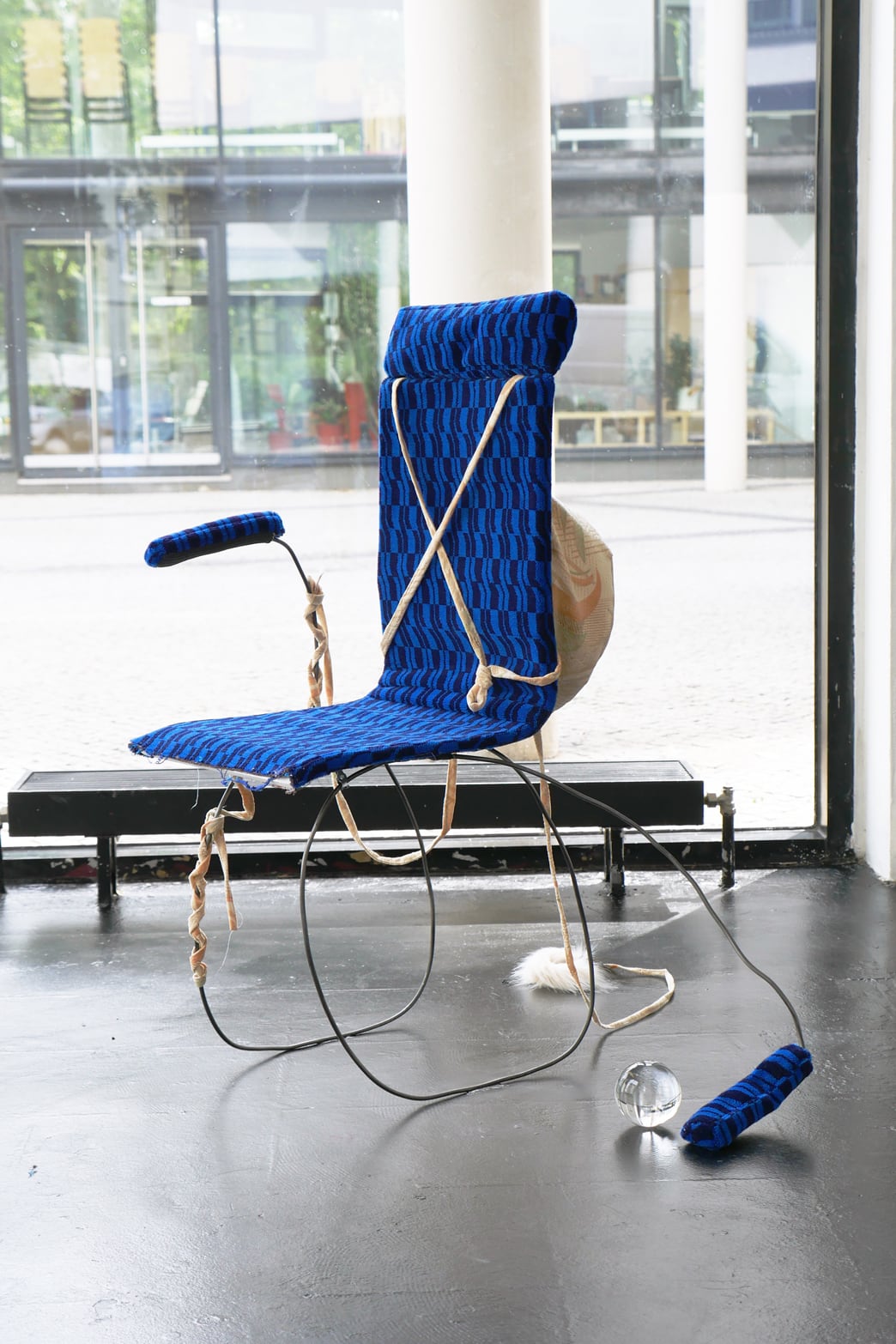 Nina Wiesnagrotzki, Dragon (Seven), Installation view at the Berlin Art Prize 2018 / fabric, wooden chair, wire, crystal sphere, 100 x 150 x 60 cm
Nina Wiesnagrotzki, Dragon (Seven), Installation view at the Berlin Art Prize 2018 / fabric, wooden chair, wire, crystal sphere, 100 x 150 x 60 cm
Natalya Serkova: We now observe the culture that is penetrated by the trending ‘weird’ objects. Films are made about inhuman beings coexisting side by side with ordinary people, fashion changes the human silhouette beyond recognition, recent
KFC’s ads depicts Colonel Sanders playing banjo shaped like fried chicken ... References to the post-human, anti-human and beyond-human seem to permeate the language. In art, the ‘weirdness’ trend is gradually, but consistently, beginning to take over. The Western world seems to have thrown all its strength into the scrutiny of objects that Heidegger could only dream of. In particular, object-oriented philosophy achieved popularity in a way no other philosophical trend of the last decades could. In your opinion, what can be connected with the popularity of this topic today, and what is it, in your opinion, in the object-oriented theory that managed to cause such a wide resonance, stretching far beyond the philosophical academic circles?
Graham Harman: First, I should point out that some people may be using ‘weird’ in a wider sense than I normally do. For me, the weird has a precise technical sense: a situation in which objects exist in tension with their own qualities rather than being reducible to them. Admittedly, this is also how I define aesthetics more generally, so for me there is a bit of weirdness in all genuine aesthetic experience. In English, the witches in Shakespeare’s MacBeth are called ‘the weird sisters,’ and of course H.P. Lovecraft wrote what he called weird fiction for the magazine Weird Tales. This is roughly the same sense in which I use the term. You ask my opinion as to why object-oriented philosophy has caught on in so many different fields. The first factor is that the theme of objects and their qualities and relations is one that speak to every possible field. Some forms of Speculative Realism simply continue to assert that “Science” is the fundamental mode of knowledge and everything else, including philosophy, must bow down to the findings of Science. Object-oriented philosophy never did this. We take the special requirements of each field seriously, and since no one likes to be told they are the mere servants of some other discipline, I think people appreciate us for that. But I also want to give a good deal of credit to Bruno Latour. His Actor-Network Theory, despite my well-known disagreements with parts of it, is an extremely powerful theory with a broad interdisciplinary scope. A large part of my readership seems to be people who were already part of Latour’s readership. This is just one of the many ways in which I am indebted to him. When historians write someday about the end of the modern period in theory, I am sure that Latour will be at the center of that story.
 Nina Wiesnagrotzki, Dragon (Four), Installation view at the Berlin Art Prize 2018 / fabric, wooden chair, wire, crystal sphere, 140 x 50 x 60 cm
Nina Wiesnagrotzki, Dragon (Four), Installation view at the Berlin Art Prize 2018 / fabric, wooden chair, wire, crystal sphere, 140 x 50 x 60 cm
 Nina Wiesnagrotzki, Dragon (Four), Installation view at the Berlin Art Prize 2018 / fabric, wooden chair, wire, crystal sphere, 140 x 50 x 60 cm
Nina Wiesnagrotzki, Dragon (Four), Installation view at the Berlin Art Prize 2018 / fabric, wooden chair, wire, crystal sphere, 140 x 50 x 60 cm
NS: In Latour's Reassembling the Social I was impressed by the concept of plasma, a surplus that always remains outside the scope of the data we receive, but which seems to continue to have an impact on actors and networks. In this sense, your object, which is always greater than its manifestations, simultaneously argues with Latour and in a certain sense corresponds to Latour's concept of plasma. If I understand correctly, this "plasmatic" part of the object is the technical weirdness that you are talking about. However, as far as I understand, plasma, despite its "fluid" name, in the particular case of your objects remains the same thing that is firmly and unshakably present in the object, always. Something like the "soul" of an object that cannot be touched, but without which the object will become nothing more than a set of its parts. In your opinion, is it possible to exhaust the weirdness of the object (what seems to be happening consistently with any phenomenon, from Shakespeare's witches and Lovecraft's heroes to the figure of Donald Trump) and how does the object resist the "exhaustion" of this weirdness?
GH: The problem I have with Latour’s plasma—and I discussed this in Prince of Networks—is that it is too much like the pre-Socratic apeiron. His plasma is completely unformatted, and therefore every object has the same plasma underlying it. But how can there be a jump from something unified and completely formless to a different level where everything is individual and discrete. This problem already haunts the theories of Anaximenes, Parmenides, and Anaxagoras, and it haunted Latour as well. (Notice that he doesn’t speak about plasma anymore.) As for how the object resists being exhausted, I don’t think it needs to resist, since I would put the problem in the opposite way. If I perceive a fire, this perception is a compound entity that includes both me and the fire. If cotton interacts with a fire, this interaction in turn is a compound that includes both the cotton and the fire. The fire is the same no matter what it interacts with, but “fire plus me” and “fire plus cotton” are obviously different. The object “fire” cannot be understood as nothing but all the combinations into which it enters. Instead, the fire must pre-exist each of those combinations, none of which deploys its full reality.
 Nina Wiesnagrotzki, Dragon (Three), Installation view at Center, Berlin, 2018 / fabric, wooden chair, wire, crystal sphere, 140 x 50 x 60 cm / Image: Frank Sperling
Nina Wiesnagrotzki, Dragon (Three), Installation view at Center, Berlin, 2018 / fabric, wooden chair, wire, crystal sphere, 140 x 50 x 60 cm / Image: Frank Sperling
NS: It turns out that the weirdness of the object is always safe. In any case, if I understand correctly, in order to be able to capture something that hasn't been noticed and described in the object before, it's necessary to establish new connections of the object each time, or create that connections yourself. Here, I see the emergence of a certain tension between the synchronic and diachronic approaches. It seems that the diachrony of cause-effect relationship cannot give us the added knowledge that the game-like, speculative spontaneity of synchronous assemblies can provide. In what relation do these approaches for production of actual knowledge about objects (and of the new objects themselves) reside and what approach seems to you the most relevant, methodologically?
GH: It’s interesting that you bring up the relation between the synchronic and diachronic aspects of object relations. It is my view that far too much attention has been paid to the question of causal relations that unfold across time, with too little attention to the causal relations within a given instant that we know as part-whole relations. In Quentin Meillassoux’s philosophy, for instance, there is a very dramatic conception of the laws of nature being able to change in the future for no reason whatsoever. Yet he never raises the more interesting question of why the laws of nature should hold universally at any given moment in the first place. Don’t get me wrong: I think that they do. But I also think that Meillassoux doesn’t face the hard version of contingency, which has to do with whether the same assembly of molecules in this moment will always lead to the same chemical as a result. If he’s really such a strong advocate of radical contingency, then he needs to let it erupt in a single moment too, and not just across time.
 Nina Wiesnagrotzki, Dragon (One), Installation view at Center, Berlin, 2018 / fabric, wooden chair, wire, crystal sphere, 100 x 150 x 60 cm
Nina Wiesnagrotzki, Dragon (One), Installation view at Center, Berlin, 2018 / fabric, wooden chair, wire, crystal sphere, 100 x 150 x 60 cm
NS: However, from my point of view, Meillassoux’s approach indirectly allows you to focus on the given instant. In particular, due to his suggestions, duration of the moment, the proverbial here and now, which has for some reason been trending lately, gains priority over any casual relations and, thus becomes terribly similar to the orthodox Christian approach of the Apostle Paul, and that is also very interesting. In contemporary art I see a reflection of this in the change of the way art is produced by the artist, which entails a change in the perception of works of art by the viewer. Artists are increasingly trying to move away from direct and unambiguous statements, the phrase ‘this work is about that’ in relation to the object of art is rapidly becoming a thing of the past. On a formal level, this is expressed in the very ‘weird’ trend from which I began our conversation—the viewer's gaze is forced to stumble and stop at the object in an attempt to understand it. In your opinion, what would be the most relevant and accurate way of analyzing the artistic method of the author and perception of art by the viewer?
GH: I think we disagree about Meillassoux, because I find him to be entirely “diachronic” rather than “synchronic” in his approach to philosophy. As for your other question, Nietzsche and Heidegger are largely responsible for the demand that we focus on art from the creator’s point of view rather than the beholder’s point of view. I disagree with them, and tend to see the creator of art as an especially well-equipped spectator. Nietzsche also makes it needlessly sexist by calling art focused on the spectator “woman’s aesthetics,” and he associates it with passivity—though anyone who’s been on the earth for more than a few decades will quickly realize that identifying women with passivity is a naive misreading of human life. Anyway, there are obviously still differences in the techniques used by the two. You speak about the artist needing to make the beholder stumble and stop. This is true, though it probably always has been: it’s simply of question of making them stumble and stop in the right place! But in the end there are probably two different kinds of artists. One kind wants to guide you to a very specific place and cuts channels that you have to follow. Another kind creates a feast of numerous different delicacies and lets you decide the order in which to sample them. Actually, we can classify whole genres this way as well. With novels you have to read the words in order, and so you go exactly where the novelist wants you to go. With film that is even more the case, since you have to sit there the whole time until the film is finished, at least if you’re watching in the cinema. The same for music. But then think about architecture, where you proceed through the building at your own pace and along your own path. I’ve often thought that the fine arts have missed a possible innovation by not arranging multiple different attractions in space just like architecture, then letting people explore them at their own pace.